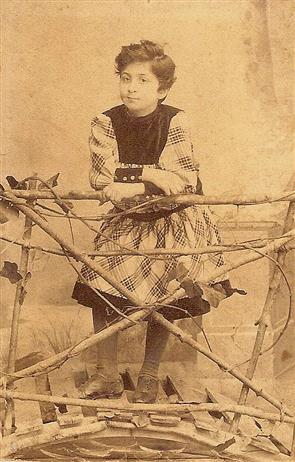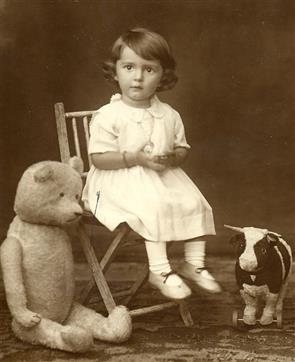


Alexandra de Hadeln - Balaceano (1911-1977)
Draft for a biographie
"The sailing boats streak the lake and trace a dark wake… someone passed there.
May your life leave its trace in the world the same way”
(Alexandra Balaceano, Territet 6th May 1931)
1911, 3rd March
(or 18 February according to the Julian calendar) birth in Bucharest of Alexandra Eugenia Sclia-Balaceano, second daughter of Jean Sclia (+1918), engineer and Marguerite Eugenia Balaceano (1883-1971) de Scaeni, only daughter of Pierre Balaceano, landowner and judge at the High Court in Ploesti and Hélène Popovici, of a family in Brasov. Thus, through her mother, her family descends from a royal line, the Cretulescus, Filittis and Popovicis… According to more recent research, carried out by Prof. Constantin Balaceano-Stolnici, the family can be traced back to Vlad the monk (1452-1495), half-brother of Prince Dracula… One of the most famous Balaceanos, Constantin, prefect, minister of foreign affairs, friend of Napoleon III, died in Nice around 1910.
All her life Alexandra would remain jealous of her elder sister Yvonne (1908-1978) - a brilliant and and coddled woman, one of the few at the time to get a degree from the Institute of Political Science in Paris (1930)- for Alexandra was convinced, undoubtedly wrongly so, to have been born – as she often said – “by sheer accident.” Her parents separated in 1912, shortly after her birth. There was no lack of talent in the family: her mother Marguerite painted still-lives and it was said she gave a piano recital in Dresden while at boarding school (1901-1904) and her cousins Anghel, daughters of a sculptor, were at one time opera singers at the Monte Carlo Opera.
1916, 6th December
After the collapse of the Romanian front at Vulcan, Szurduk and Tirgu Jiu in November, the German army entered Bucharest while the Romanian army set fire to the petroleum wells to avoid them getting into enemy hands, the royal family and other families of royal blood took refuge in Moldavia and the government installed itself in Jassy. The Balaceanos were soon on their way to France like so many others and established themselves in Aix-les-Bains where they lived comfortably for a while thanks to the petroleum income from their estate in Romania.
1918-1928
Alexandra Balaceano, better known to her friends as Didi, spent her childhood in France between Aix-les-Bains and Chambéry. She spent a short while at a girls' boarding school – Convent of the Sacred Heart in Lyon, together with her elder sister Yvonne followed by the Lycée Victor Duruy in Paris. However she probably got her French baccalaureate in Chambéry before entering the National School of Art in Lyon where she studied with the engraver André Jacques.
1930-1933
During this period, thanks to a family friend, Henry Mermoz, owner of the Grand Hotel Albion “Palais des Alpes” in Aix-les-Bains, she received her first “commission” to paint 22 pictures, some quite big, to decorate the hotel dining room, the lounge and the smoking room. The hotel was destroyed by a fire during its renovation a few years later.
1931-1932
Family trip to Switzerland: from 1 May to June she spent a short time at the Fisher Institute, Chateau d’Arvel, Territet Montreux, where she was photographed painting, surrounded by her family. The two sisters went to see a fortune teller in Geneva, Mme Hotz, who gave each a 14 page manuscript in which she predicted a turbulent future.
Like many Romanians, Alexandra was rather superstitious. During 1931 Alexandra kept a diary containing many thoughts on life, man with a capital M. and love. We sense her loneliness: “if I’m alone forever, why burden myself with all these colourless and transparent people who snake through the world? They’ve cast a net of such narrow opinions across my path that no one slips through. But I’ll manage to fight it with my tense nerves. I don’t like men, I like the MAN”. She left Territet for Ostend (20 July), then Brussels (6 August) and finally Paris (7 August) where she discovered Egyptian and Indian art at the Louvre. On 23 January1932, she left for London with her family, then for Florence before returning to Paris.
1932-1933
Alxandra Balaceano studies at the Ecole du Louvre in Paris. She follows courses at the Grande Chaumière and becomes a student of André Lhote. On 24 August 1933, Alexandra passes her driving test which is validated by an Italian licence on 5 March 1937.
1933 21 April
Family trip to Italy, followed by a second one on 18 October. It is during one of these trips in 1932 or 1933 that she will meet her future husband, Baron Harry von Hadeln-Hudson, born in 1907, West Hartlepool (Yorkshire), the adopted son of German art historian Detlev, Freiherr von Hadeln. An extensive correspondence between them shows a passionate love affair.
A bronze bust of Harry dates from 1933. There are several successive trips to Italy, 4 January, 1934, 4 April 1934, 26 July 1934. On 22 October 1934 she leaves for London to join her fiancé. She enrols at the Slade School and studies with the sculptor Charles Wheeler.
1934 5-30 December
With the help of the Romanian diplomat Georges Caranfil, she holds her first solo exhibition of 6 sculptures at the Leger Gallery in London,
1935-1939
Alexandra exhibits sculptures at the Royal Academy of Sculpture, London and participates in “Salon d'Automne” in Paris.







1935, 8 May.
New trip to Florence, after her fiancé’s father’s death, followed by a second trip 5 September. On 30 October 1935, civil wedding of Alexandra and Harry at Aix-les-Bains town hall. The church wedding is held shortly after in the Russian Orthodox cathedral in Geneva.
1936 22 August
Birth in Florence of her first child, Maurizio von Hadeln, who dies 5 day later.
1935-1939
Alexandra learns to ride and her husband gives her a horse called “Panurge”. She participates in several show-jumping events of which one in 1937 in Bucharest – her last trip to Romania. She studies at the Academy of Fine Arts in Florence and follows a painting course with painter and sculptor Italo Griselli (1880-1958). She makes several sculptures among which huge huge ones, a rider and a crucifix, and also paints a series of portraits.

page 1 of 4





